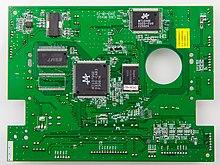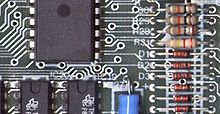

A printed circuit board (PCB), also called printed wiring board (PWB), is a medium used to connect or "wire" components to one another in a circuit. It takes the form of a laminated sandwich structure of conductive and insulating layers: each of the conductive layers is designed with a pattern of traces, planes and other features (similar to wires on a flat surface) etched from one or more sheet layers of copper laminated onto or between sheet layers of a non-conductive substrate.[1] Electrical components may be fixed to conductive pads on the outer layers, generally by means of soldering, which both electrically connects and mechanically fastens the components to the board. Another manufacturing process adds vias, drilled holes that allow electrical interconnections between conductive layers.
Printed circuit boards are used in nearly all electronic products. Alternatives to PCBs include wire wrap and point-to-point construction, both once popular but now rarely used. PCBs require additional design effort to lay out the circuit, but manufacturing and assembly can be automated. Electronic design automation software is available to do much of the work of layout. Mass-producing circuits with PCBs is cheaper and faster than with other wiring methods, as components are mounted and wired in one operation. Large numbers of PCBs can be fabricated at the same time, and the layout has to be done only once. PCBs can also be made manually in small quantities, with reduced benefits.[2]
PCBs can be single-sided (one copper layer), double-sided (two copper layers on both sides of one substrate layer), or multi-layer (outer and inner layers of copper, alternating with layers of substrate). Multi-layer PCBs allow for much higher component density, because circuit traces on the inner layers would otherwise take up surface space between components. The rise in popularity of multilayer PCBs with more than two, and especially with more than four, copper planes was concurrent with the adoption of surface mount technology. However, multilayer PCBs make repair, analysis, and field modification of circuits much more difficult and usually impractical.
The world market for bare PCBs exceeded $60.2 billion in 2014[3] and is estimated to reach $79 billion by 2024.[4][5]
- ^ "What Is a Printed Circuit Board (PCB)? - Technical Articles". AllAboutCircuits.com. Retrieved June 24, 2021.
- ^ "Printed Circuit Board – An Overview". ScienceDirect. Retrieved June 24, 2021.
- ^ "World PCB Production in 2014 Estimated at $60.2B". iconnect007. September 28, 2015. Retrieved April 12, 2016.
- ^ "Global Printed Circuit Board (PCB) Market to Witness a CAGR of 3.1% during 2018-2024". GlobeNewswire News Room. Energias Market Research. Retrieved August 26, 2018.
- ^ "Global Single Sided Printed Circuit Board Market – Growth, Future Prospects and Competitive Analysis and Forecast 2018–2023". The Industry Herald. August 21, 2018. Archived from the original on March 2, 2022.